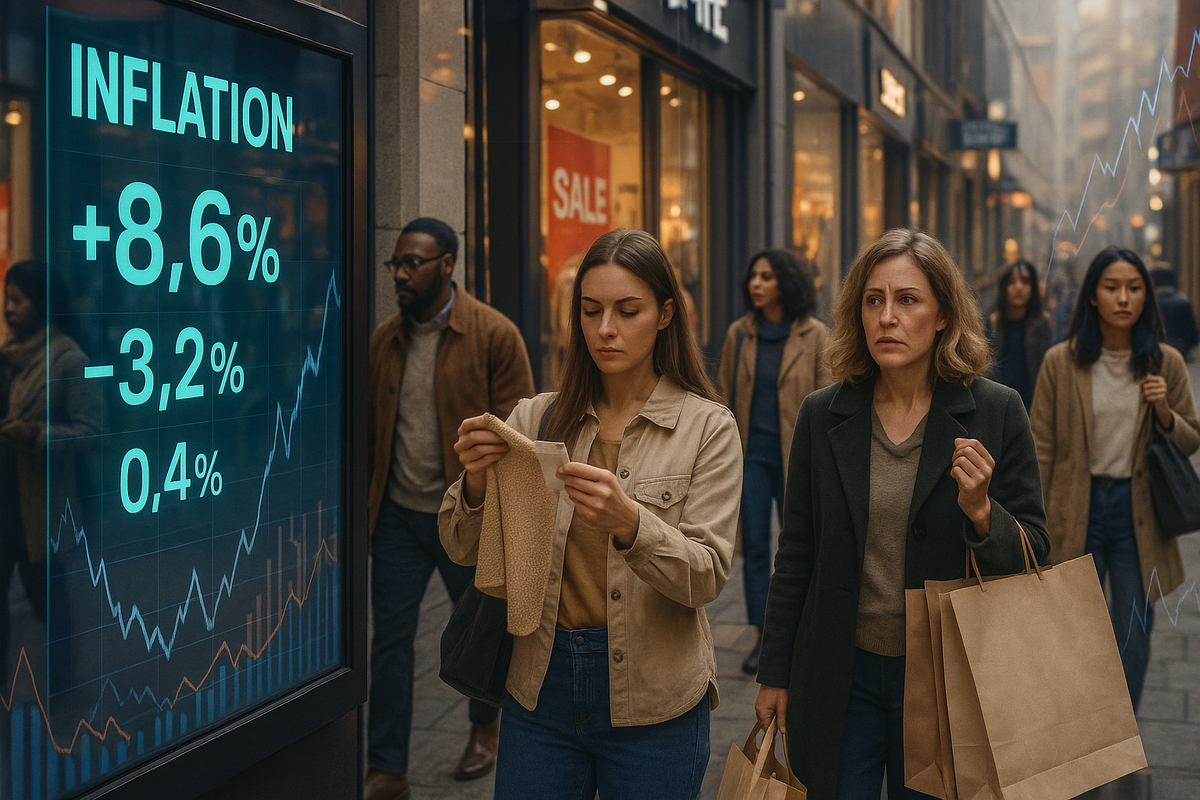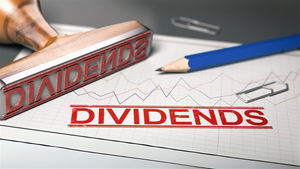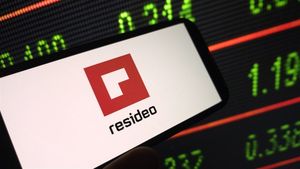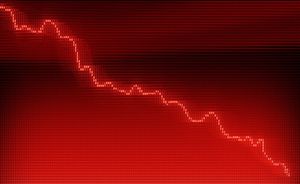Financial News
Consumer Spending Under Scrutiny: Inflationary Pressures and Their Impact on Market Dynamics

Consumer spending, a cornerstone of economic growth, is currently facing intense scrutiny as persistent inflationary pressures continue to erode purchasing power and reshape market dynamics. While consumers have demonstrated a degree of resilience, particularly among higher-income households, a discernible trend of caution, value-seeking, and strategic spending adjustments is emerging. This shift is impacting various sectors and contributing to a projected slowdown in overall economic growth, raising concerns about the trajectory of the economy in the coming months.
The immediate implication of this sustained inflation is a direct reduction in what each dollar can buy, forcing households to make difficult choices about their expenditures. This erosion of purchasing power is not merely a theoretical concept; it translates into tangible changes in daily life, from grocery shopping to major discretionary purchases. The ripple effects are already being felt across industries, prompting businesses to re-evaluate strategies and investors to recalibrate their expectations for market performance.
The Unyielding Grip of Inflation: What Happened and Why It Matters
The current economic landscape is characterized by a persistent, albeit decelerating, inflationary environment that continues to exert significant pressure on consumer spending. While inflation rates have eased from their peaks, prices remain elevated compared to pre-inflationary levels, creating a challenging environment for households and businesses alike. This sustained inflation is not just a statistical anomaly; it's a fundamental shift that is altering consumer behavior and, consequently, the broader economic outlook.
Specifically, consumer spending growth is projected to decelerate in 2025. Morgan Stanley (MS) forecasts a weakening in U.S. consumer spending growth to 3.7% in 2025 from 5.7% in 2024, while EY projects real personal consumption expenditures to slow from 2.8% in 2024 to 1.9% in 2025 and 1.4% in 2026. Fitch Ratings also noted a significant slowdown in U.S. consumer spending during the first half of 2025. This slowdown, despite low unemployment rates and some proactive purchases made in anticipation of tariff-related price increases, underscores a pervasive sense of caution among consumers, leading many to reconsider large purchases.
Key shifts in consumer behavior include a prioritization of essentials, with budgets increasingly focused on items like groceries and pet food, while discretionary spending in categories such as electronics, mid-tier luxury goods, apparel, and home exercise equipment sees significant cutbacks. A strong emphasis on value is driving behaviors like buying fewer items, opting for cheaper alternatives, switching to store brands, actively hunting for deals, and consolidating shopping trips. Interestingly, despite economic concerns, 59% of consumers still prioritize spending on experiences, and a majority (57%) are conducting extensive research before making purchasing decisions. The trend towards digital and cashless transactions and the growth of subscription services also continue.
Retail sales data reflects these shifts. While overall retail sales showed some resilience in June and July 2025, boosted by vehicle sales, clothing, and building materials, there were declines in volumes for electronics, appliances, and home furnishings. When adjusted for inflation, retail sales volumes appear softer. The National Retail Federation (NRF) forecasts overall retail sales growth between 2.7% and 3.7% in 2025. Spending patterns also reveal a growing disparity based on income, with lower- and middle-income consumers more visibly reducing spending and trading down, while higher earners, though also seeking discounts, tend to maintain their brand preferences more often.
Navigating the Shifting Tides: Winners and Losers in a High-Inflation Environment
The current economic climate, marked by persistent inflation and cautious consumer spending, is creating a distinct divide between companies that are well-positioned to adapt and those that will struggle. Businesses that cater to essential needs, offer compelling value, or provide sought-after experiences are likely to emerge as relative winners, while those heavily reliant on discretionary spending or unable to absorb rising costs may face significant headwinds.
Companies in the consumer staples sector, particularly those focused on groceries and household essentials, are likely to see continued demand. Retailers like Walmart (NYSE: WMT) and Costco Wholesale Corporation (NASDAQ: COST), known for their value propositions and bulk purchasing options, are well-positioned to capture budget-conscious consumers. Similarly, private label brands and discount retailers are gaining traction as consumers actively seek cheaper alternatives. Companies that can effectively manage their supply chains and pass on minimal cost increases to consumers will also fare better.
Conversely, companies in discretionary sectors such as high-end electronics, luxury goods, and certain apparel segments are likely to experience reduced demand. Brands that cater to mid-tier luxury or non-essential items may find consumers trading down or postponing purchases. For example, companies like Apple Inc. (NASDAQ: AAPL), while having a strong brand loyalty, might see some consumers delay upgrades or opt for more affordable models. Similarly, businesses in the home furnishings and appliance sectors could face challenges as consumers defer large household purchases. The travel and leisure industry, while benefiting from the "experiences over possessions" trend, may see a shift towards more budget-friendly options or shorter trips.
Furthermore, businesses with high operating costs and limited pricing power will struggle to maintain profit margins in an inflationary environment. Companies that cannot effectively pass on increased input costs to consumers without significantly impacting demand will face pressure on their bottom line. This could lead to reduced investment, slower growth, and potential job losses in affected sectors. The ability to innovate, streamline operations, and offer genuine value will be crucial for companies to not only survive but thrive in this evolving market.
Broader Implications: Industry Shifts and Regulatory Responses
The sustained inflationary pressures and the resulting shifts in consumer spending are not isolated events; they are part of a broader economic transformation with significant industry-wide implications. This environment is accelerating existing trends, creating new challenges, and prompting a re-evaluation of business strategies across various sectors. The ripple effects extend beyond individual companies, influencing competitive landscapes, regulatory frameworks, and even the long-term trajectory of the economy.
One of the most significant broader trends is the intensification of competition in the value segment. As consumers become more price-sensitive, companies are forced to compete more aggressively on price and promotions. This could lead to price wars in certain categories, further squeezing profit margins for businesses. Retailers are increasingly investing in private label brands and loyalty programs to retain customers and offer perceived value. This also puts pressure on national brands to justify their premium pricing.
The supply chain remains a critical vulnerability. While some supply chain issues have eased, new tariffs, as mentioned in the research, could re-accelerate inflation and create fresh disruptions. Companies that have diversified their supply chains and built in greater resilience will be better positioned to mitigate these risks. The focus on nearshoring or reshoring production could gain further momentum as businesses seek to reduce their reliance on volatile global supply networks.
Regulatory and policy implications are also significant. Central banks, like the Federal Reserve, are walking a tightrope, aiming to tame inflation without triggering a recession. The expectation of potential interest rate cuts in late 2025 and early 2026, contingent on inflation subsiding, highlights the delicate balance. However, if tariffs cause inflation to intensify, the Fed might be compelled to consider rate hikes, which would further dampen consumer spending and economic growth. Governments may also face pressure to implement policies that provide relief to consumers, such as tax breaks or subsidies, though such measures could also exacerbate inflationary pressures if not carefully managed.
Historically, periods of sustained inflation have often led to significant shifts in consumer behavior and industry structures. Comparisons can be drawn to the 1970s, a decade marked by high inflation and economic stagnation. While the current environment differs in many respects, the emphasis on value, the cautious approach to discretionary spending, and the focus on essential goods echo some of the patterns observed during that era. Businesses that learn from these historical precedents and adapt their strategies accordingly will be better equipped to navigate the challenges ahead.
What Comes Next: Navigating Uncertainty and Seizing Opportunities
The path forward for consumer spending and the broader economy remains characterized by a degree of uncertainty, yet several short-term and long-term possibilities are emerging. Businesses and investors alike will need to remain agile, adapting to evolving market conditions and strategically positioning themselves to capitalize on new opportunities while mitigating potential risks.
In the short term, consumer caution is likely to persist, particularly among lower- and middle-income households. This suggests continued strength in value-oriented retailers and essential goods, while discretionary spending may remain subdued. Companies will need to focus on compelling value propositions, targeted promotions, and efficient inventory management to navigate this environment. The impact of new tariffs will be a critical factor to watch, as they could re-accelerate inflation and further dampen consumer sentiment. Businesses should be prepared for potential supply chain disruptions and increased input costs.
Long-term, the emphasis on value, convenience, and experiences is likely to endure. Companies that can innovate to deliver these attributes effectively will be well-positioned for sustained growth. This could involve further investment in e-commerce capabilities, personalized marketing, and subscription models. The shift towards digital and cashless transactions is also a long-term trend that businesses must embrace. Furthermore, the growing disparity in spending patterns based on income suggests that companies will need to tailor their offerings to different consumer segments more precisely.
Potential strategic pivots or adaptations required include a renewed focus on operational efficiency and cost control to protect profit margins. Businesses may need to re-evaluate their product portfolios, shedding underperforming lines and investing in those that align with evolving consumer preferences. Diversification of revenue streams and a greater emphasis on customer loyalty programs will also be crucial. For investors, this environment presents both challenges and opportunities. Sectors resilient to inflation, such as consumer staples and healthcare, may offer relative stability. However, growth opportunities could emerge in companies that demonstrate strong innovation, adaptability, and a clear value proposition in a challenging economic climate.
Potential scenarios and outcomes range from a "soft landing," where inflation gradually subsides without a significant recession, to a more challenging "stagflationary turn" if tariffs intensify inflationary pressures while economic growth remains sluggish. The Federal Reserve's monetary policy decisions will play a pivotal role in shaping these outcomes. Businesses and investors should closely monitor inflation data, consumer sentiment indicators, and central bank communications to anticipate potential shifts and adjust their strategies accordingly.
Conclusion: A New Era of Prudent Consumption
The current economic landscape, defined by persistent inflationary pressures and a cautious consumer, marks a significant turning point for financial markets and public companies. The era of unbridled discretionary spending has given way to a new era of prudent consumption, where value, necessity, and experience take precedence. This shift is not merely a temporary blip but a fundamental recalibration of consumer behavior that will have lasting implications for how businesses operate and how investors allocate capital.
The key takeaway from this period is the enduring power of the consumer, even when faced with economic headwinds. While spending patterns have changed, consumers are still actively participating in the economy, albeit with a more discerning eye. Businesses that understand and adapt to these evolving preferences – by offering compelling value, prioritizing essential needs, and delivering meaningful experiences – will be the ones that thrive. The ability to manage costs effectively, innovate strategically, and build resilient supply chains will be paramount for sustained success.
Moving forward, investors should closely watch several key indicators. Inflation data, particularly the Consumer Price Index (CPI) and the Personal Consumption Expenditures (PCE) price index, will provide crucial insights into the trajectory of prices. Consumer confidence surveys and retail sales figures will offer a pulse check on spending behavior. Furthermore, the Federal Reserve's monetary policy decisions, especially regarding interest rates, will significantly influence market dynamics. The impact of new tariffs on both inflation and corporate profitability will also be a critical factor to monitor.
Ultimately, this period of scrutiny over consumer spending and inflationary pressures is shaping a more resilient and adaptable market. While challenges remain, the companies and investors who embrace these changes, prioritize long-term value, and remain responsive to the evolving needs of the consumer will be best positioned to navigate the complexities of the coming months and emerge stronger in the new economic paradigm.
More News
View More





Quotes delayed at least 20 minutes.
By accessing this page, you agree to the following
Privacy Policy and Terms Of Service.



